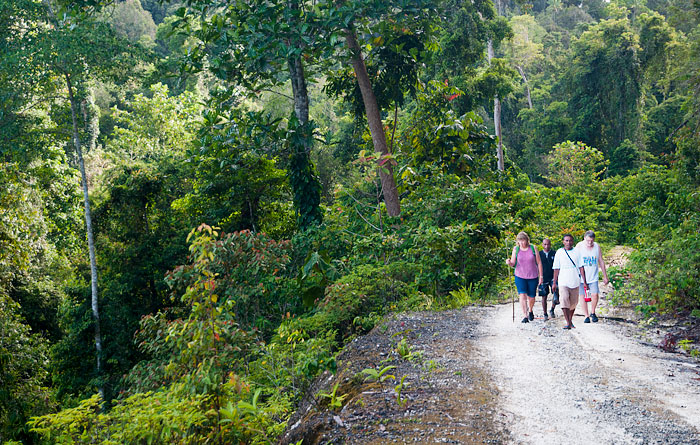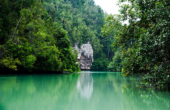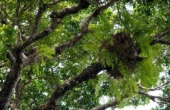When it’s time to leave the water, there’s a host of things to see and do on land.
How to organise land based adventures in Raja Ampat
There are many tour companies and independent guides who can organise an itinerary of your choice for exploring the wonders of the Raja Ampat islands. Tours can be as simple as a quick bird watching trip out of Sorong, or you can embark on an extended trekking and camping trip through the jungles of Batanta or the vast Waigeo interior and highlands.
It’s easy to organise spur of the moment day trips too. Almost every village has local guides happy to show you the hidden wonders of their island home.
Birding and Birds of Paradise
Raja Ampat has long been famed for its Birds of Paradise, the ancient trade in the feathers of which drew the famed British naturalist Alfred Wallace to the islands in 1860. Since that time over 250 avian species have been described in the islands, including many endemic species like Wilson’s Bird of Paradise (Waigeo and Batanta), the Red Bird of Paradise (Waigeo and Gam), Kofiau Island’s Kofiau Monarch and Paradise Kingfisher and Waigeo’s Brujin’s Bush Turkey.
Some of these iconic species can be easily seen during a short excursion – to set eyes on others will require patience and an extended jungle trek. Regardless of your level of commitment, birdlife on the islands is rich and varied – no matter where you are, you’ll be hearing birdsong throughout the day. Guide Simon Kolomsusu can take you in Wallace’s footsteps to the site of the naturalist’s Raja Ampat research camp where you can also observe the dawn mating display of Red Birds of Paradise. Waigeo guides Benny Mambrasar and Franky Mambrasar can show you the jungle display grounds of Waigeo’s Wilson’s Bird of Paradise and all Gam homestays provide tours to see dawn displays of Red Birds of Paradise.
Check out professional birding guide Steve Anyon-Smith’s detailed Birding in Raja Ampat trip report for everything you need to know to organise your own tropical island birding holiday.
Jungle trekking and wildlife observation
The Ambel Maya villages of Waifoi and Warimak on Waigeo have developed fabulous rainforest trekking and Mayalibit Bay tour packages. See incredible landscapes, hundreds of bird species and rare and endemic fauna and flora. Staying in village homestays and jungle camps, these treks will also introduce you to Raja Ampat’s original culture: That of the Maya people from whom Mayalibit Bay takes its name.
The four biggest islands of Raja Ampat – Waigeo, Salawati, Misool and Batanta – harbour an incredible range of wildlife in diverse habitats. It will take time and patience to see even a fraction of the jungle’s larger inhabitants, but a sharp eye will spot plenty of the animal kindom’s smaller representatives. Waterfalls, crystal clear rivers, ancient burial grounds and the remains of jungle villages long since abandoned for coastal settlements may be encountered. Even on the smaller islands like Gam, Kri and Mansuar, the jungles afford the opportunity of some amazing encounters. They also afford the chance of getting completely lost, so – if you have no guide – don’t wander too far in pursuit of the source of those strange sounds! Pak Daud Mayor at Warikaf Homestay offers long treks through the Gam wilderness. Freddy Sauyai, the owner of Koryau Kayem Homestay on Mansuar is from Batanta and can organise tours of the jewels of that less visited island.
If your specific area of interest is birding, here’s an encyclopaedic Raja Ampat birding report, complete with locations, sighting records and more.
Cultural and village tours
In addition to the prehistoric sites mentioned above, there’s a wealth of more recent historic and significant sites in Raja Ampat. Relics of the era of the Four Kings, jungle groves that still shelter bamboo containers used in pre-Christian rites, World War II remains – there’s a lot to see. Immersion in present day culture is guaranteed if you stay in homestays in villages. Most villages have guides who can introduce you to kampung life, or you can contract the services of guides like Christian Sauyai, who can design custom itineraries for cultural (and other) tours.
Low tide coastal exploration
Tides in Raja Ampat have a maximum range of about two metres, which can expose a vast amount of reef and sandbank in some areas. There are two low tides every 24 hours, so almost every day there’ll be a period when you can explore exposed reefs and walk beaches that are non-existent at high tide. If you do explore reef areas at low tide, please read our Health and Medical page so you’re aware of the risks. You should always have foot protection and should never walk on or touch coral or the marine creatures you’ll encounter. You’ll see wonderful stuff anywhere you take a walk at low tide – here’s a few suggestions:
- Explore the sandbanks that join the islands of Kri and Mansuar.
- Pick your way carefully among the coral fringed pools of the exposed reef to the east of Sawinggrai village on Gam.
- Walk the beaches between Waigeo’s Warimpurem Homestay and Saporkren village and refresh yourself at the cool and voluminous freshwater springs that the low tide exposes.
See the photos in the gallery at the top of this page for a taste of the sights…
Climb a mountain
Well, not really a mountain, but a steep, high hill with one of the best views in the world from its summit! Mount Pindito lies in the heart of Wayag’s magical green-clothed rock islands. A fairytale landscape emerging from tropical seas in the north-west of Raja Ampat, Wayag is the subject of the definitive image of the Raja Ampat islands. It’s the picture everyone wants to see. You have to go a very long way to see it. It’s also the single most expensive trip you can make in Raja Ampat. The karst island seascape of Piaynemo is virtually identical, although on a far smaller scale – see it in the gallery above. Piaynemo is also less remote, much cheaper to visit and, unlike Wayag, has homestay accommodation. See Piaynemo Homestay’s page for more info.
Explore caves and rock art galleries
Misool Island‘s karst landscape reaches amazing scale in the giant Tomolol Cave. Sacred to local Muslim people, the cave entrance is protected by a shrine, but the cave can be explored via the veritable river that flows through it. Tours using rubber boats or float rings can be arranged.
If you visit Tomolol, make sure you also take time to visit the rock art galleries that adorn island overhangs and cave walls nearby. Estimated at somewhere between three and five thousand years old, the enigmatic ochre paintings are still in fine condition and give a glimpse of a way of life long since vanished.
Also in the area are limestone cliff burial sites that still contain the skeletal remains of other ancient island residents. Exceedingly fragile and bearing a patina of moss and lichen, the skulls and bones of these graves are relics of a much more recent time than the cave paintings, but still bear witness to a culture long gone from the islands.
Visit a pearl farm
On the western coast of Waigeo, the fjordlike entrance to Aljui Bay hides the Cendana Pearl Farm and provides the sheltered waters vital to the cultivation of these jewels of the sea. Demonstrations of pearl oyster seeding and an insight into the time-consuming care and diligence required to successfully produce quality pearls can be had on a visit here. Selpele homestays provide the perfect base to explore Aljui Bay.
Tour a sea turtle rookery
It’s a bit of a stretch to call a visit to the remote islands of north-west Raja Ampat a “land based adventure”: getting there will require spending a lot of time on the water! Worth it for fans of sea turtles and pristine uninhabited tropical islands though – especially if you’re already planning to visit the Wayag group.
Raja Ampat is a major breeding area for both the Hawksbill and the Green Sea Turtle, and the turtle-tracked, soft sandy beaches of Sayang and Piai islands host substantial Green Turtle rookeries. Turtles come ashore almost every night of the year, with peak numbers between March and June, the time of year when seas are usually calm. (A good thing, given the length of the journey to the islands!)
If you want to see turtles actually nesting or hatching, you’ll probably need to spend a night or two on the islands. To do so will require bringing food, water and camping gear with you and ensuring you leave no trace of your stay when you leave.
Bon Wauw Homestay at Manyaifun has 2 day/1 night camping trips to Sayang. The trip also includes a stopover at Wayag.
The Sayang-Piai-Wayag Sea Turtle Conservation Program has a permanently manned monitoring station on Pulau Piai and you should make this your first stop, especially if you plan on camping on either of the islands. If you’d like to make enquiries or give advance notice of your arrival, you can do so by email to Ferdiel Ballamu at the Alternate email address listed in the project details page linked above.
Other contacts for land based adventures in Raja Ampat
- Papua Expeditions come highly recommended, are specialists in bird watching tours and can organise custom itineraries of any kind. Visit Papua Expeditions’ website for further information and a sampling of their range of Raja Ampat ecotours.
- The Raja Ampat Homestay Information Center in Waisai can put you in touch with guides and tour organisers if you arrive without having made prior arrangements.




